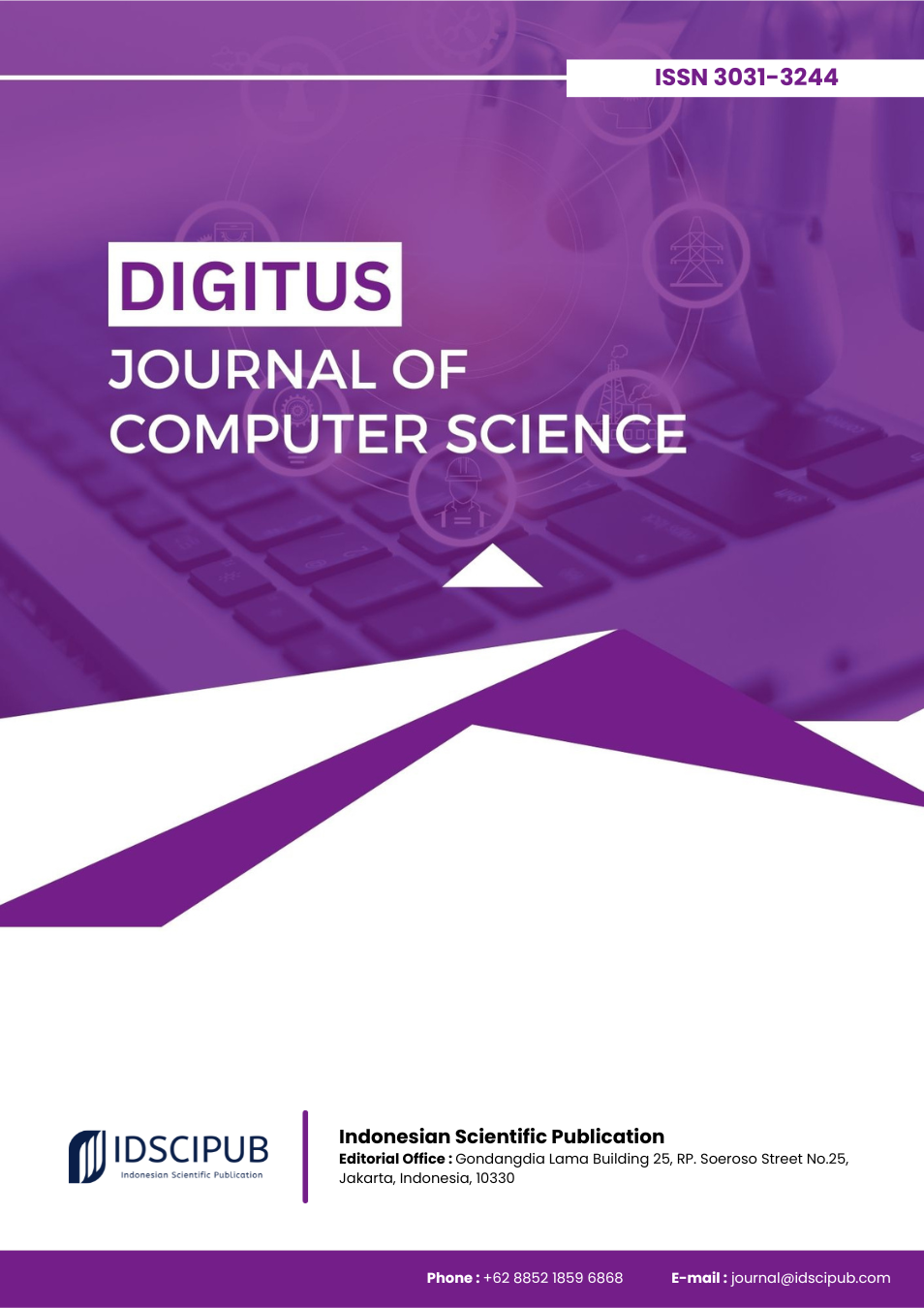Adaptive and User-Centered HCI for Intelligent Technologies: A Global Perspective
DOI:
https://doi.org/10.61978/digitus.v2i4.854Keywords:
Human-Computer Interaction, Intelligent Systems, User Interface Design, Accessibility, Usability Testing, User-Centered Design, Inclusive TechnologyAbstract
Human-Computer Interaction (HCI) within intelligent systems plays a critical role in shaping user experience, particularly through effective design, usability, and accessibility. This narrative review aims to synthesize current research trends and challenges in designing inclusive and adaptive HCI environments. Literature was gathered from Scopus and Google Scholar using keywords such as "Human-Computer Interaction," "Intelligent Systems," "Usability," "Accessibility," and "User-Centered Design." Articles were selected based on inclusion criteria focusing on recent, peer-reviewed studies that explore empirical, review, and case-based methodologies. The results highlight that effective user interface design is rooted in multimodal, emotionally aware, and cognitively efficient interactions. AI-enhanced features and adaptive layouts contribute to a more intuitive experience, particularly in healthcare and smart vehicle environments. Usability assessments, including the System Usability Scale and A/B testing, further validate user engagement and system effectiveness. Accessibility remains a crucial yet underrepresented theme, with a significant disparity in inclusive design for vulnerable populations. Notably, best practices from countries with strong accessibility policies underscore the importance of integrating users with disabilities into the design process. The discussion points to systemic factors—such as regulatory frameworks, digital literacy, and funding priorities—as both barriers and enablers of progress. To bridge existing gaps, the study recommends further longitudinal, cross-cultural, and inclusive research. Strengthening digital education and accessibility policies is key to enhancing user-centered innovation in intelligent systems.
References
Asl, A., Toribio-Guzmán, J., Castro‐González, Á., Malfáz, M., Salichs, M., & Franco, M. (2024). Evaluating the user experience and usability of the mini robot for elderly adults with mild dementia and mild cognitive impairment: insights and recommendations. Sensors, 24(22), 7180. https://doi.org/10.3390/s24227180 DOI: https://doi.org/10.3390/s24227180
Bai, X., Yuan, J., Liu, M., Huang, H., & Feng, J. (2024). Human factors considerations of interaction between wearers and intelligent lower-limb prostheses: a prospective discussion. Journal of Neuroengineering and Rehabilitation, 21(1). https://doi.org/10.1186/s12984-024-01475-x DOI: https://doi.org/10.1186/s12984-024-01475-x
Babu, V., Oliveira, L., Birrell, S., Taylor, A., & Cain, R. (2018). Comparison of e-ink and oled screens as train seat displays: a user study., 294-300. https://doi.org/10.1007/978-3-319-93710-6_30 DOI: https://doi.org/10.1007/978-3-319-93710-6_30
Borsci, S. and Schmettow, M. (2024). Re-examining the chatbot usability scale (bus-11) to assess user experience with customer relationship management chatbots. Personal and Ubiquitous Computing, 28(6), 1033-1044. https://doi.org/10.1007/s00779-024-01834-4 DOI: https://doi.org/10.1007/s00779-024-01834-4
Buschek, D., Eiband, M., & Hußmann, H. (2022). How to support users in understanding intelligent systems? An analysis and conceptual framework of user questions considering user mindsets, involvement, and knowledge outcomes. ACM Transactions on Interactive Intelligent Systems, 12(4), 1-27. https://doi.org/10.1145/3519264 DOI: https://doi.org/10.1145/3519264
Cervantes-Solis, J. and Baber, C. (2017). Towards the definition of a modelling framework for meaningful human-iot interactions. https://doi.org/10.14236/ewic/hci2017.28 DOI: https://doi.org/10.14236/ewic/HCI2017.28
Chughtai, R., Zhang, S., & Craig, S. (2015). Usability evaluation of intelligent tutoring system. Proceedings of the Human Factors and Ergonomics Society Annual Meeting, 59(1), 367-371. https://doi.org/10.1177/1541931215591076 DOI: https://doi.org/10.1177/1541931215591076
Clark, L., Doyle, P., Garaialde, D., Gilmartin, E., Schlögl, S., Edlund, J., … & Cowan, B. (2019). The state of speech in hci: trends, themes and challenges. Interacting With Computers, 31(4), 349-371. https://doi.org/10.1093/iwc/iwz016 DOI: https://doi.org/10.1093/iwc/iwz016
Dell’Aquila, E., Ponticorvo, M., & Limone, P. (2025). Psychological foundations for effective human–computer interaction in education. Applied Sciences, 15(6), 3194. https://doi.org/10.3390/app15063194 DOI: https://doi.org/10.3390/app15063194
Díaz-Rodríguez, N., Lilius, J., Cuéllar, M., & Calvo-Flores, M. (2013). Rapid prototyping of semantic applications in smart spaces with a visual rule language., 1335-1338. https://doi.org/10.1145/2494091.2499217 DOI: https://doi.org/10.1145/2494091.2499217
Dunbar, S., Macpherson, B., Moretti, E., Fiol, G., Bolte, J., Taekman, J., … & Wright, M. (2016). Toward designing information display to support critical care. Applied Clinical Informatics, 07(04), 912-929. https://doi.org/10.4338/aci-2016-03-ra-0033 DOI: https://doi.org/10.4338/ACI-2016-03-RA-0033
Ehrlich-Sommer, F. (2025). Robot usability in the wild: bridging accessibility gaps for diverse user groups in complex forestry operations. Universal Access in the Information Society. https://doi.org/10.1007/s10209-025-01234-2 DOI: https://doi.org/10.1007/s10209-025-01234-2
Faria, B., Vasconcelos, S., Reis, L., & Lau, N. (2013). Evaluation of distinct input methods of an intelligent wheelchair in simulated and real environments: a performance and usability study. Assistive Technology, 25(2), 88-98. https://doi.org/10.1080/10400435.2012.723297 DOI: https://doi.org/10.1080/10400435.2012.723297
Feth, D., Maier, A., & Polst, S. (2017). A user-centered model for usable security and privacy., 74-89. https://doi.org/10.1007/978-3-319-58460-7_6 DOI: https://doi.org/10.1007/978-3-319-58460-7_6
Flohr, L., Beaudry, S., Johnson, K., West, N., Burns, C., Ansermino, J., … & Görges, M. (2018). Clinician-driven design of vitalpad–an intelligent monitoring and communication device to improve patient safety in the intensive care unit. IEEE Journal of Translational Engineering in Health and Medicine, 6, 1-14. https://doi.org/10.1109/jtehm.2018.2812162 DOI: https://doi.org/10.1109/JTEHM.2018.2812162
Giariskanis, F., Kritikos, Y., Protopapadaki, E., Papanastasiou, A., Papadopoulou, E., & Mania, K. (2025). Dynamic difficulty adjustment in audio augmented reality games. Journal on Computing and Cultural Heritage, 18(2), 1-19. https://doi.org/10.1145/3718330 DOI: https://doi.org/10.1145/3718330
Kim, H., Hwang, H., Gwak, S., Yoon, J., & Park, K. (2024). Improving communication and promoting social inclusion for hearing-impaired users: usability evaluation and design recommendations for assistive mobile applications. PLOS ONE, 19(7), e0305726. https://doi.org/10.1371/journal.pone.0305726 DOI: https://doi.org/10.1371/journal.pone.0305726
Knijnenburg, B. and Willemsen, M. (2016). Inferring capabilities of intelligent agents from their external traits. ACM Transactions on Interactive Intelligent Systems, 6(4), 1-25. https://doi.org/10.1145/2963106 DOI: https://doi.org/10.1145/2963106
Lin, Y., Min, H., Zhou, H., & Pei, F. (2018). A human–robot-environment interactive reasoning mechanism for object sorting robot. IEEE Transactions on Cognitive and Developmental Systems, 10(3), 611-623. https://doi.org/10.1109/tcds.2017.2706975 DOI: https://doi.org/10.1109/TCDS.2017.2706975
Longo, L. and Dondio, P. (2015). On the relationship between perception of usability and subjective mental workload of web interfaces. https://doi.org/10.1109/wi-iat.2015.157 DOI: https://doi.org/10.1109/WI-IAT.2015.157
Maia, R., Silva, J., & Silva, J. (2019). Towards graphical user interface redefinition without source code access., 1-6. https://doi.org/10.1145/3338286.3344398 DOI: https://doi.org/10.1145/3338286.3344398
Mercado, J., Rupp, M., Chen, J., Barnes, M., Barber, D., & Procci, K. (2016). Intelligent agent transparency in human–agent teaming for multi-uxv management. Human Factors the Journal of the Human Factors and Ergonomics Society, 58(3), 401-415. https://doi.org/10.1177/0018720815621206 DOI: https://doi.org/10.1177/0018720815621206
Tremoulet, P., Seacrist, T., McIntosh, C., Loeb, H., DiPietro, A., & Tushak, S. (2019). Transporting children in autonomous vehicles: an exploratory study. Human Factors the Journal of the Human Factors and Ergonomics Society, 62(2), 278-287. https://doi.org/10.1177/0018720819853993 DOI: https://doi.org/10.1177/0018720819853993
Väänänen, K., Olsson, T., & Häkkilä, J. (2015). Towards deeper understanding of user experience with ubiquitous computing systems: systematic literature review and design framework., 384-401. https://doi.org/10.1007/978-3-319-22698-9_26 DOI: https://doi.org/10.1007/978-3-319-22698-9_26
Virvou, M. (2023). Artificial intelligence and user experience in reciprocity: contributions and state of the art. Intelligent Decision Technologies, 17(1), 73-125. https://doi.org/10.3233/idt-230092 DOI: https://doi.org/10.3233/IDT-230092
Wardle, G. and Sušnjak, T. (2025). Image first or text first? Optimising the sequencing of modalities in large language model prompting and reasoning tasks. Big Data and Cognitive Computing, 9(6), 149. https://doi.org/10.3390/bdcc9060149 DOI: https://doi.org/10.3390/bdcc9060149
Yang, M. and Huang, H. (2015). Research on interaction design of intelligent mobile phone for the elderly based on the user experience., 528-536. https://doi.org/10.1007/978-3-319-20892-3_51 DOI: https://doi.org/10.1007/978-3-319-20892-3_51
Yao, Y., Basdeo, J., Kaushik, S., & Wang, Y. (2019). Defending my castle., 1-12. https://doi.org/10.1145/3290605.3300428 DOI: https://doi.org/10.1145/3290605.3300428
You, F., Yang, Y., Fu, M., Zhang, J., & Wang, J. (2021). Design guidelines for the size and length of Chinese characters displayed in the intelligent vehicle’s central console interface. Information, 12(5), 213. https://doi.org/10.3390/info12050213 DOI: https://doi.org/10.3390/info12050213
Zhang, E., Yang, Z., Zhao, W., Mei, Z., Xia, Y., & Chen, F. (2024). Unlocking brilliance: a smart approach to icon colour design inspired by universal design principles. Buildings, 14(6), 1522. https://doi.org/10.3390/buildings14061522 DOI: https://doi.org/10.3390/buildings14061522
Zhang, T., Xie, S., & Liao, Q. (2025). Smart in-vehicle system user interfaces: designing for human-machine interaction and cognitive load reduction. https://doi.org/10.3233/faia250286 DOI: https://doi.org/10.3233/FAIA250286





